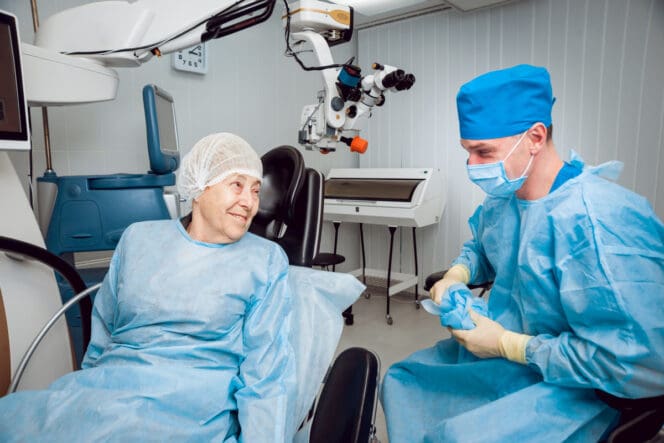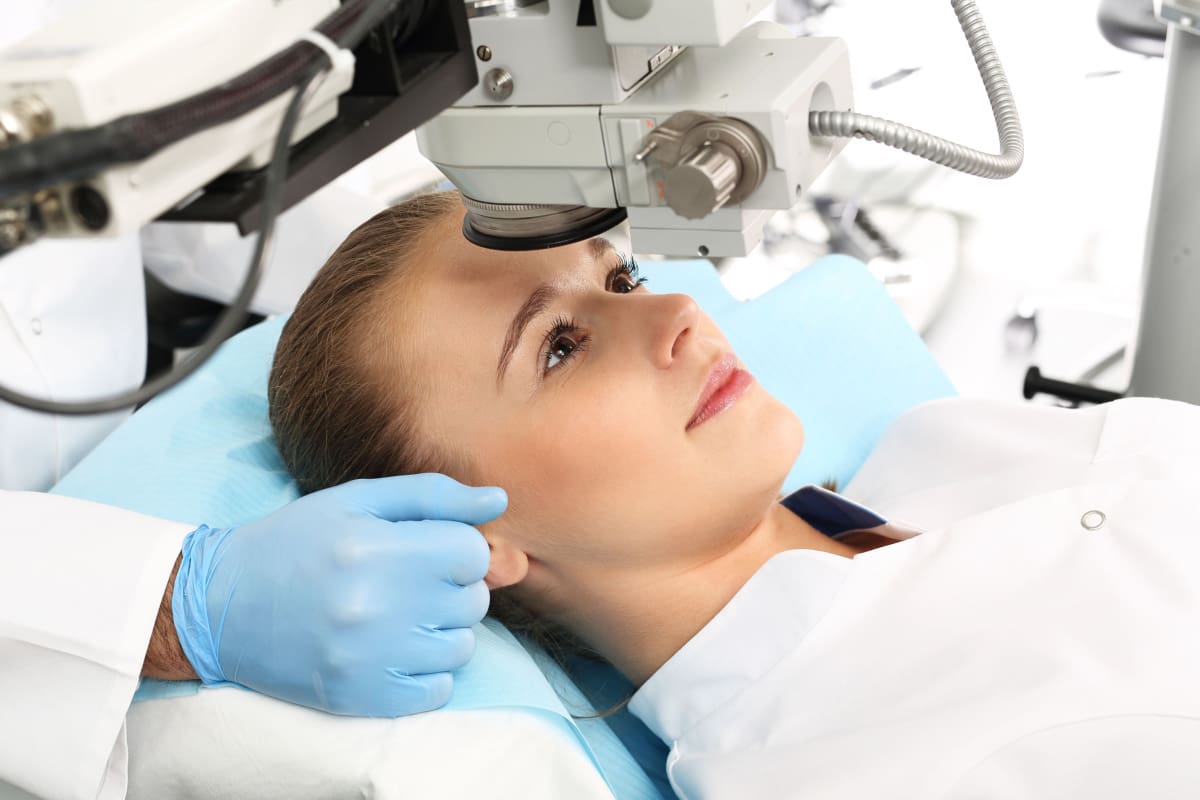Laser cataract surgery is a procedure where the eye’s cloudy lens is replaced with a clear man-made lens.
The purpose of this innovative surgery is to remove the cataract and reduce reliance on prescription eyewear.
What Happens During Laser Cataract Surgery?
Laser-assisted cataract surgery is a specific procedure that uses a camera to map the eye’s surface. This device employs ultrasound to gather information, which is sent to a computer controlling the laser.
This information is used to create a 3D map of your eye. It ensures that the incision’s depth, location, and size are extremely precise.
The laser can be used to make an incision in the cornea and create an opening in the eye’s capsule. The laser can also be used to weaken the cataract, allowing it to be removed more easily.
Using a probe, the surgeon gently breaks down the lens into tiny pieces and delicately suctions these pieces out of your eye. At this point, the cataract has been removed from the eye.
The surgeon inserts the artificial clear lens, or intraocular lens (IOL), in the eye, using guidelines for proper positioning. Typically, the incision is self-healing and does not require stitches.

Who Performs Laser Cataract Surgery?
Ophthalmologists perform cataract surgery, but not all ophthalmologists perform laser cataract surgery. Confirm the surgeon you’re interested in is trained in laser cataract surgery specifically.
To find eye surgeons in your area, you can use the American Academy of Ophthalmology’s Find an Optometrist tool.
Who Is a Candidate?
If you have a cataract and are in good overall health, you may be a good candidate for laser cataract surgery. However, only specific people are eligible for laser cataract surgery.
According to the American Academy of Ophthalmology, only certain patients qualify for Medicare guidelines for laser cataract surgery. Your ophthalmologist can offer this procedure if you have astigmatism you would like corrected during cataract surgery.
To correct astigmatism, you may opt for a premium lens such as a toric or multifocal IOL. With a premium lens, you may be a candidate for this surgery. Use of a laser allows them to better place the IOL, which can result in better vision after surgery.
The National Eye Institute estimates that approximately half of adults in the U.S. don’t have 20/20 vision due to refractive errors. According to the National Eye Institute, astigmatism is one of the conditions that causes vision problems due to refractive errors.
With astigmatism, objects appear blurry due to the cornea having an irregular curvature. Patients with this refractive error are not able to clearly see both far-away and nearby objects.
Who Is Not a Candidate?
If you have had cataract or glaucoma surgery in the past, you may not be a candidate for laser cataract surgery. Likewise, if you don’t have astigmatism or choose a premium IOL, you may not qualify.
Other issues can potentially make you ineligible for laser cataract surgery, such as scarring on your eyes, issues with pupil function, or general health issues.
Contradictions
Talk to your doctor to discuss whether you are a candidate for this surgery. According to the University of Michigan Kellogg Eye Institute, most cataract patients are candidates for laser cataract surgery.
How to Prepare for Laser Cataract Surgery
Generally, you will have an initial consultation with your eye doctor to discuss different surgical options and treatments. During this consultation, your ophthalmologist will conduct an exam, take measurements of your eyes, and perform tests.
If you have any questions, this is the time to ask your surgeon, so you can have peace of mind about your procedure.

The Procedure
Before laser cataract surgery, your surgeon will make a precise 3D map of the structures of your eye. This provides your surgeon with exact detail about where to make incisions. Using this detailed 3D map, your surgeon uses the laser to create those incisions.
Your surgeon will make a near-perfect circular opening to access and remove the cataract. With the opening created, the laser is used to soften and gently break up the cataract into tiny pieces. This allows for easy removal, using much less ultrasound energy than traditional surgery.
A precise probe is used to remove the fragments before inserting an intraocular lens.
Most often, the entire surgery takes less than half an hour. The 3D imaging and laser treatment often only take a few minutes.
Most people experience little discomfort during the surgery. You will be awake during the procedure, but they will use a medicine to numb your eye. During the laser portion of the procedure, you may feel slight pressure and see a kaleidoscope image of lights.
Your eye care team may place a protective shield over your eyes after the surgery. You’ll spend some time resting in a recovery room where a nurse will check on you.
Many people go home about 30 minutes after surgery. Be sure to arrange to have someone drive you home, as you will be unable to drive.
Recovery & Aftercare
Recovery time from either laser or traditional cataract surgery is the same. Some patients report vision clarity after surgery, while others find it takes about a week or two for their vision to clear.
According to the American Academy of Ophthalmology, full recovery takes anywhere from four weeks to approximately three months.
During the recovery period, you may experience some discomfort, soreness, or stinging sensations in your eye. Talk with your surgeon about pain medication to reduce soreness.
It is important to not rub your eyes. If you rub them, you can cause damage and slow the healing process.
During recovery, your eyes may feel itchy or watery. You may notice an increased sensitivity to light.
In the 24 hours after surgery, do not get your eye wet. Avoid strenuous exercise or heavy lifting. Ideally, take a few days off work to rest and recover. Avoid swimming, hot tubs, and saunas for about four weeks.
Laser Cataract Surgery Risks
As with any surgery, there are potential risks to laser cataract surgery.
You may experience some changes in your vision, such as dry eyes, increased sensitivity to light, and seeing double vision or halos around lights. These are generally temporary and improve within a few weeks to months.
This surgery is associated with an increased risk of developing secondary cataracts. A secondary cataract may require a follow-up surgery.
Other risks include bleeding, infection, and swelling. Though rare, your IOL could become dislocated after the procedure.
Talk with your surgeon to understand your potential risks.
Benefits of Laser Cataract Surgery
As cataract surgery technology evolves, it is being called “the fountain of youth.” Vision is restored in a way that many patients never imagined possible. With technology improvements, many people find laser cataract surgery improves their overall quality of life.
The biggest benefits of laser cataract surgery are twofold. First, the cataract is removed. Second, vision is restored and people can see clearly without the need for prescription eyeglasses or contact lenses. In some cases, vision is considerably better and the need for eyewear is drastically reduced.
According to the University of Michigan Kellogg Eye Institute, laser cataract surgery offers a gentler cataract removal, more precise treatment, and more options to correct astigmatism than traditional cataract surgery.
Laser vs. Traditional Cataract Surgery
Most insurance plans do not cover laser cataract surgery. According to Medicare guidelines, laser surgery can only be offered to certain patients who have astigmatisms that they want corrected during cataract surgery.
Generally, laser cataract surgery is more expensive than traditional cataract surgery. Some insurers cover only a portion of the cost of this procedure.
However, many people choose to have the surgery to enjoy the benefits of being less dependent on glasses. They pay the difference out of pocket as a result.
According to the American Academy of Ophthalmology, laser surgery has the advantage of being extremely precise. The precision enables surgeons to correctly see and map the precise lens capsule. This allows for precise placement and centering of the IOL, essential for placing premium lenses.
Laser Cataract Surgery Evaluation
If you are considering having laser cataract surgery, talk with your surgeon. According to the University of Rochester Flaum Eye Institute, a good first step to determine if laser surgery is the best treatment for your lifestyle is to fill out a lifestyle questionnaire.
It is important to understand that while your reliance on glasses may be reduced, you may still need to wear prescription glasses or contacts for some activities. Talk to your surgeon about how best to set your expectations before the procedure.
Laser Cataract Surgery FAQs
Is laser surgery better for cataracts?
Laser surgery offers advantages for specific types of cataracts. With laser technology, the surgeon has increased accuracy and precision compared to standard cataract surgery.
Surgery outcomes are connected to the ultimate desired result. If the outcome is to reduce reliance on glasses, laser surgery for cataracts is often the preferred method.
Laser cataract surgery provides precise placement for a multifocal IOL and reduces dependence on corrective eyewear after surgery.
What is the difference between traditional cataract surgery and laser cataract surgery?
Laser cataract surgery allows for more precise incisions and more detailed placement of the IOL. It can also break up the cataract with less ultrasound energy.
Traditional surgery uses handheld surgical instruments rather than lasers. As a result, laser surgery is recognized as more precise and accurate overall.
What are the disadvantages of laser cataract surgery?
Laser cataract surgery is more expensive, and most insurance plans do not cover the cost. In some cases, it may be covered if astigmatism is present and to be corrected during surgery. Consult your surgeon’s office and insurance provider to confirm any level of coverage.
References
-
New Options in Cataract Surgery. University of Rochester Flaum Eye Institute (URMC).
-
Find an Ophthalmologist. American Academy of Ophthalmology (AAO).
-
Fact Sheet. National Eye Institute (NEI).
-
Refractive-Cataract Surgery: Overview of the Current Landscape. (May 2019). Ophthalmology Times.
-
Refractive Cataract Surgery Overview. University of Central Florida (UCF)
-
Laser Cataract Surgery FAQs. University of Michigan Kellogg Eye Center (UMK)
-
Lifestyle Questionnaire. University of Rochester Flaum Eye Institute (URMC).
-
Femtosecond Laser–Assisted Cataract Surgery Compared With Phacoemulsification Cataract Surgery: Randomized Noninferiority Trial With 1-Year Outcomes. (October 2020). Journal of Cataract & Refractive Surgery.
Last Updated June 8, 2022
Note: This page should not serve as a substitute for professional medical advice from a doctor or specialist. Please review our about page for more information.